Romance and realism in Raymond Chandler's The Big Sleep
Federica Bologna
In questo saggio, Federica Bologna va alla ricerca di elementi realisti e romanzeschi in The Big Sleep di Raymond Chandler, non trovandosi pienamente d'accordo con la dichiarazione dell'autore di essere uno scrittore realista.
1. Introduction
2. Time and Space in The Big Sleep
3. Marlowe: a 1930’s knight in Los Angeles
4. Supporting characters in The Big Sleep
5. Conclusion
6. Bibliography
1. Introduction
To identify the romantic and realistic elements of Raymond Chandler’s The Big Sleep, it is necessary to clarify what “romance” actually is. Using the words and knowledge of Paolo Zanotti:
Il romance non è un genere letterario codificato [...] è piuttosto quello che si può definire un modo, cioè una serie di costanti dell’immaginario che si possono riflettere in letteratura all’interno di opere appartenenti a generi diversi. [...] Il modo romanzesco spazia quindi dalla fantasticheria [...] alla narrativa seria o di consumo, dal fumetto al cinema, e può benissimo essere una componente tra le altre del novel ottocentesco. (Zanotti 1998:8)
According to Zanotti, the Italian adjective romanzesco (equivalent to romantic in English) expresses the idea of unlikelihood, of adventure, and of fulfillment of desire: «romanzesca è un’opera con un intreccio ricco di colpi di scena e avventure, in particolare cavalleresche» (Zanotti, 1998:6).
Indeed, the term “romance” was originally used to define the French chivalric romance, but the historical origins of romance as a modality can be traced to the chivalric romance of the 13th and 14th century in general.
However, as Zanotti claims, modes transform over time to adapt to the ever changing social, economic and political scenes. As a result, the well-known images that characterize the chivalric romance - for example, the knight, the dame, the forest, the castle and the monster – mutate in their appearance, but remain in their essential core and meaning (Zanotti, 1998:17-23). This is evident in The Big Sleep.
The decision to analyze this novel from this specific perspective, comparing realistic and romantic elements, came after reading Chandler’s essay The Simple Art of Murder (1950). In fact, in this essay, the author commits himself to realism, criticizing the English tradition of the straight-deductive novel of detection for its far-fetched plots and trite strategies. He also praises Dashiell Hammett’s works for taking «murder out of the Venetian vase and dropped it into the alley» (Chandler 1950:10), for giving it «back to the kind of people that commit it for reasons, not just to provide a corpse» (Chandler 1950:10), and for representing murder as the «act of infinite cruelty» (Chandler 1950:10), that it is.
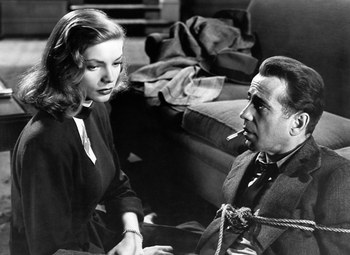
However, for Chandler, even Hammett is not good enough, as he «did not wreck the formal detective story» (Chandler 1950:10), he did not draw the «not very fragrant world» (Chandler 1950:12). What Chandler was actually looking for in art – despite his bitter statements – was not “the real” but «redemption» (Chandler 1950:12) and truth, as can be noticed in the final part of the essay:
[…] down these mean streets a man must go who is not himself mean, who is neither tarnished nor afraid. The detective in this kind of story must be such a man. He is the hero, he is everything. He must be a complete man and a common man and yet an unusual man. He must be, to use a rather weathered phrase, a man of honor, by instinct, by inevitability, without thought of it, and certainly without saying it. […] He talks as the man of his age talks […] The story is his adventure in search of a hidden truth. (Chandler 1950:12)
As many may realize, these few lines are tremendously romantic.
In 1950, after World War II and the holocaust, Chandler is still able to talk about a non-fragmented, non-inept, and non-hypocrite “hero”. His detective is a truly romantic individual who cannot be contaminated by society – like Goffredo in Jerusalem Delivered - but is still capable of living inside that same society.
Furthermore, he seeks spiritual perfection as an old-fashioned French knight (Zanotti 1998:9-11). All these traits can be detected in the Philip Marlowe of The Big Sleep, but before talking in depth about the protagonist, it is important to analyze the environment in which he navigates.
2. Time and Space in The Big Sleep
One of the most relevant parts of the novel for our analysis is the incipit of the book. Indeed, the author gives the specific time-space coordinates of the narration right from the start, which is a strategy clearly used to add realism – the writer also appeases us with information regarding the weather:
It was about eleven o’clock in the morning, mid-October, with the sun not shining and a look of hard wet rain in the clearness of the foothills. (Chandler 1939:3).
Proceeding through the first page of the novel, the reader can also notice one of the most realistic elements of Chandler’s style: the use of extremely detailed descriptions to make sceneries and landscapes pop out of the book and persuade the most critical reader that they actually exist.
Description is usually considered a realistic strategy, exploited by the realistic tradition born around the 18th century. In fact, as some may know, Stendhal – a true lover of middle-age chivalric romance and a bizarre romantic character - despised material description (Stendhal 1892). He found it boring and useless to represent the human heart and its glorious and frightening passions.
Also, in A Gossip on Romance (1882), Stevenson clearly explains that the simple and pure events – opposed to descriptions - are the main substance of any novel of adventure, the part that interests the reader the most (Stevenson, 1882).
However, the most innocent romantic readers can easily notice that most of such endless, boring and meticulous descriptions contain some uncanny elements that reveal the writer’s intention of creating an atmosphere worth the adventure that will soon take place.
For example, inside the description of the Sternwood mansion printed on the first page of the novel, the reader can encounter «the entrance door, which would have let in a troop of Indian elephants» and «a broad stained-glass panel showing a knight in dark armor rescuing a lady who was tied to a tree» (Chandler, 1939:3). As a result, describing a number of doors, stairs, floors, plants and elements of furniture, the villas of the wealthy population of Los Angeles suddenly appear like one of the labyrinthine castles of the European Middle-Ages.
Further in the book, the author keeps pointing out the time and location of the narration and describing what surrounds it in detail, yet these places feel like atmospheres constantly emanating a sensation of mystery and fable. When describing the meeting between Mr. Sternwood and Philip Marlowe, Chandler refers to the greenhouse that surrounds them and the General himself with terms related to a decaying natural world:
«unreal greenish color […] meaty leaves and stalk like the newly washed fingers of dead men […] dry white hair [..] like wild flowers fighting for life on a bare rock» (Chandler, 1939:7).
As a result, the reader is bewildered not only by «the cloying smell of tropical orchids» (Chandler, 1939:7), but also that of nostalgia, a typical emotion of romance (Frye, 1957).
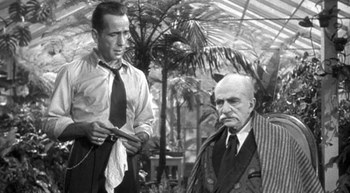
Other relevant and strange descriptions are: the one regarding Vivian Sternwood’s room:
This room was too big, the ceiling was too high, the doors were too tall […] the white made the ivory look dirty and the ivory made the white look bled out […] There was already pressure in the air (Chandler, 1939:17)
the one about the surroundings of Geiger’s house :
As the darkness folded back on it and ate it up a thin tinkling scream echoed out and lost itself among the rain-drenched trees (Chandler, 1939:33)
the one about The Cypress Club:
a general air of nostalgic decay (Chandler, 1939:130)
but in particular, the description of the place where Carmen fires at Marlowe – «a daydream land» (ivi p. 217) perfect for a murder -, which is what made the prosperity of the Sternwood family but also stained the hands of their descendants with murder.
Using Stevenson’s words, it can be said that all of these settings are examples of genius loci, the favorite places of romance, or those that make the reader feel as something is just about to happen (Stevenson, 1882).
In order to further investigate the comparison between the real and the fantastic, it is necessary to focus on the protagonist, the detective, as it is the core of the hard-boiled fiction genre.
3. Marlowe: a 1930s knight in Los Angeles
Before starting to analyze in detail the behavior of this character, it is fundamental to point out that the story is told in first-person, by the detective himself. For this reason, it is difficult to tell whether Marlowe is a romantic or realistic figure.
Part of his attitude is the result of an attempt by the author of saying the story in the most objective and credible way possible; and part has to adhere to the romantic image of the hero that Chandler draws in The Simple Art of Murder (1950). As a result, although Marlowe points out his physiological needs several times in the book, he doesn’t always satisfy them.
I was thinking about going out to lunch and that life was pretty flat (Chandler, 1939:126)
Furthermore, he tells the reader how much money he earns per day, how much money General Sternwood gives him and how much money he needs to make Agnes speak. At the same time, he never spends this money on material objects that are useful in everyday life. It is just a mere strategy to make the adventure continue.
In Roman des origines et origines du roman (1972), Marthe Robert says that errant knights escape the rules of nature and society, and they are never seen eating, working, or using money. This is particularly true of Marlowe if we also consider that he got away with the police more easily than the average person. He may also perfectly remember when and where the crime or an important moment in the plot have happened, but he loses track of time:
It was five days since I had rung it for the first time. It felt like a year (Chandler, 1939:209)
and reality and fiction blend in his memory:
My mind drifted through waves of false memory, in which I seemed to do the same thingover and over again […] and yet each time it seems real, like something actually happening (Chandler, 1939:206)
In addition, as a true romantic character, he loses consciousness at least once in the book and he uses alcohol to blur his perception and awareness of the outer world – as he tries to do at the end of the book –, which makes him have absurd dreams.
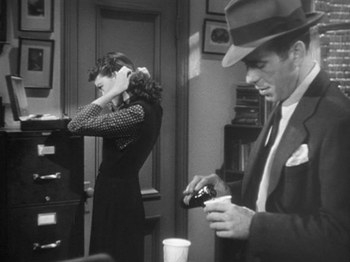
All these elements, which convey a sensation of tension between fantasies and facts, dream and reality, are extremely typical elements of romance; as Zanotti points out in his critique, descriptions of dreams are recurrent in romantic works, and usually «il momento di difficoltà [dell'eroe] […] viene spesso presentato come una specie di sonnolenza, una perdita della memoria» (Zanotti, 1998:21), just as it happens in The Big Sleep, where Marlowe faints right after meeting the villain. However, it has to be said that the main realistic element of the novel comes from Marlowe.
Throughout the book, the detective’s irony has the role of constantly keeping the reader on earth. Indeed, the reader can clearly distinguish two types of languages in the narration: that of the literary connoisseur, expert in describing characters’ appearances in detail, and that of the bitter reporter that comments on the people’s attitudes and souls, watching the world happening at his feet. His irony is detached, smooth, irreverent, and absolutely hilarious:
She bit her lip and turned her head a little and looked at me along her eyes. Then she lowered her lashes until they almost cuddled her cheeks and slowly raised them again, like a theater curtain […] that was supposed to make me roll over on my back with all four paws in the air (Chandler, 1939:3)
Deeply contaminated by irony is also the language of coolness, the one used by the “bad guys” of the book: Marlowe, Eddie Mars, Joe Brody, Harry Jones, Canino, etc. This language is particularly metaphorical, and reuses terms belonging to different fields. For example, Eddie Mars calls Marlowe «soldier», and then warns him: «If you want to pick lead out of your belly, get in my way» (Chandler, 1939:70); and later asks one of his lackeys «See if this bird is wearing any iron» (Chandler, 1939:73).
In his essay B. H. (Before Humphrey) Le vicissitudini dell’Hard-Boiled Hero negli anni Venti e Trenta (1990), Minganti calls this particular use of tones and registers:
«dialogo “in presa diretta”, duro, gergale e vernacolare, idiosincratico e comunicativo, […] largamente mediatico, […] linguaggio della gente comune» (Minganti, 1990:58).
Hence, this way of talking is a highly realistic element of the novel. However, it has to be pointed out that the hard-boiled voice is part of the wider living voice used in detectivefiction, which is a disembodied voice far from the material world:
«una voce il più delle volte distaccata che raggiunge nella narrazione in prima persona […] il suo significato più pregnante […] che parla l’esperienza e che finisce col prevalere sulla preoccupazione della definizione fisica» (ivi p. 54).
In addition, as Celati says in his book Finzioni Occidentali (2001), the free use of the first-person narration by the protagonist is a romantic element itself, since its voice is a direct expression of an empirical singularity and its liberal intensities.
Indeed, according to the realistic tradition of the 18th century, the author had to control the production of the character through several stylistic strategies - like a preface that assures the reader that the un-conscientiousness of the singularity described in the book has been limited to a bureaucratic stylistic manner more apt for the common reader. An autonomous use of language, or an uncontrolled verbal proliferation, may provoke a romantic identification of the reader with the character, the discovery of fabulation, which represents the dark side of practical and biological life (Celati, 2001).
Nonetheless, there are other aspects that contribute to Marlowe’s image of a romantic knight. Describing the knights of chivalric romances, Zanotti says: «I cavalieri protagonisti dei romanzi cortesi cercano spontaneamente l’avventura» (Zanotti, 1998:11), which is also what Marlowe does, as he keeps investigating in the disappearance of Regan even after his job with Mr. Sternwood was officially done:
The smart thing for me to do was to take another drink and forget the whole mess. That being obviously the smart thing to do, I called Eddie Mars and told him I was coming down to Las Olindas that evening to talk to him. That was how smart I was (Chandler, 1939:129)
Later in the text Zanotti also writes:
Il mondo del romance è un mondo ben ordinato, in cui ogni cosa ha un segno positivo o negativo, […] L’eroe del romance non vuole cambiare questo mondo, sarebbe inconcepibile: si limita a rivitalizzarlo, a guarire il re (Zanotti, 1998:13)
These lines become particularly true of Marlowe and his world if we consider several elements. When he explains to Vivian who a loogan is, he puts himself on the “right side of the fence”, and when she replies «I often wonder if there is a wrong side» (Chandler, 1939:148), he changes the topic of the conversation. And although he says «it wasn’t a game for knights» (ivi p. 156) - when he has to deal with the presence of Carmen on his bed - a knight is exactly what he is: he refuses both Vivian’s and Carmen’s attentions, and by doing so he discovers who killed Regan.
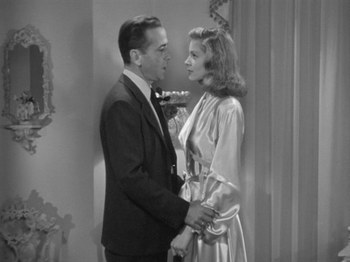
Also, he might say «I was part of the nastiness now» (ivi p. 230) at the end of the book, but in reality, helping the Sternwood’s sisters to get away with the murder is a noble act, since it allows their father to stay out of the same nastiness and to die peacefully. Furthermore, he kills the villain of the book without subverting the system. He remains in that corrupted world as any other knight would do.
4. Supporting characters in The Big Sleep
To continue our analysis of Chandler’s Big Sleep, it is now important to focus on the other characters of the book, and to divide them into romantic and realistic figures.
The first romantic persona that appears in the novel is Carmen Sternwood: she «is a child who likes to pull wings off flies» (ivi p. 13) and bites her thumb; a wild animal that makes hissing noises and shoots Regan because he refused her company. Carmen is a young woman with an unknown mental disease that makes her immature - «thinking was always going to bother her» (ivi p. 5) –, hence, she perfectly adheres to the description of the supporting character of romance outlined by Zanotti: she has no psychological depth, is passive, and is simply one of the puppets controlled by external forces or by the places where they happen to be. It can also be deduced that she is affected by what Celati calls romantic un-conscientiousness: who suffers from this type of mental condition is unable to distinguish reality from fantasies, and has a passion for what is romantic (Celati 2001).
However, as the General says, also Vivian Sternwood is a particularly romantic figure. She «is spoiled, exacting, smart and quite ruthless» (Chandler 1939:13) like many queens of the chivalric romance; she is also a reader of fiction as she knows detectives from books. Nonetheless, Vivian is more a victim of events than a creator of romance. In order to cover her sister’s crime, she is trapped in a romantic representation of life; indeed, her affair with Marlowe is just a strategy to keep the detective from investigating her family any further.
Also Mr. Sternwood can be considered a chivalric character, since he is the king of a world in decay who seeks the truth about Regan’s disappearance just like a detective.
However, the most fantastic persona of all is probably the most unseen: Silver-Wig, aka Mrs. Mars. With her lake-blue eyes and the wig, she is different from all the other characters even in her appearance. Her wig is a sign of both her love for Eddie Mars and her fictional nature. In fact, she is the perfect damsel-in-distress: a dangerous woman that yet needs to be saved. Also, she is the only character of the book who is able to sacrifice herself for another person.
Another romantic character of the book is Harry Jones: he has blue eyes as well, and his way of talking is respectful yet characterized by the same jargon of the detective. Since he appears from nowhere just to help Marlowe discover the truth and continue the adventure, he is both a guide and a literary strategy. As the protagonist himself says:
«[I] sat in my chair thinking about Harry Jones and his story. It seemed a little too pat. It had the austere simplicity of fiction rather than the tangled wool of facts» (ivi p. 169).
Although the main characters are romantic, the majority of the personas that appear in the book are realistic. Agnes, Brody, Mars, seem to have no feeling or emotion at all, they just act out of self-interest and greed. Agnes has seen three men dying around her, yet she just wants the money from Marlowe to leave the city and start a new life as soon as possible, without ever turning back.
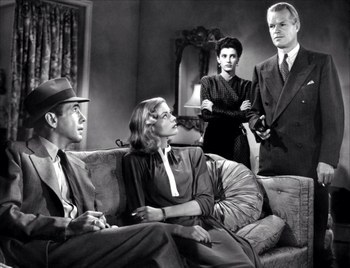
Nonetheless, while reading the book, it is easy to understand if a character is good or bad as soon as they appear in the text. All of them are characterized by a detail - a color, a habit, an object - which represents the nature of their soul, and this, as we said before, is certainly a romantic feature (Zanotti, 1998).
In addition, not one of the figures is a round character that changes over time, and their inner thoughts are not revealed to the reader– apart from Marlowe. As Zanotti claims, this makes it easier for a reader to identify himself with them, as they are personifications of abstract psychological types (ibid.).
Furthermore, all of the characters are passive and seem to be trapped in a system, as their actions are more reactions or consequences of events they did not foresee. Even Marlowe, despite his professional know-how, gets to the solution of the mystery mostly because of fortuitous situations. After all, as it is evident when summing up the plot, the whole structure of the book resembles the one of a chivalric romance, with its planned and convenient (adjective used by Marlowe himself when finding an office door open) twists and its limitless chain of events.
Also, if we think about the work of Chandler in general, the reader sees Marlowe working on one case after another and never getting old, instead always continuing his adventure; this juxtaposition of a series of adventures is very typical of the chivalric romance as both Zanotti and Frye point out:
The essential element of plot in romance is adventure, which means that romance is naturally a sequential and processional form […] it is an endless form in which a central character who never develops or ages goes through one adventure after another (Frye, 1957:186)
5. Conclusion
To conclude, I believe that the presence of so many romantic elements in The Big Sleep, in spite of the realistic aims of Chandler, are due to the intrinsic characteristics of the hard-boiled genre. In fact, the origins of this genre, as outlined in the introduction to Dimensions of Detective Fiction, are rooted in three commercial forms: the picaresque story, the gothic fiction and the domestic fiction (Landrum et al.: 1976).
All in all, detective fiction was shaped by the early Black Mask pulp magazine which featured stories by many commercial genres: mystery, detective, adventure, western, horror, and novelty (Durham, 1968); and Celati demonstrated how the realistic writers of the 18th century relegated the most evident forms of romance to commercial and children’s literature (Celati, 2001). Black Mask also created the figure of the detective - the core of the genre – giving rise to an heroic knight:
«[un] prodotto del carattere nazionale […] che assomma ad elementi miti del folk hero altri caratteristici dell’eroe moderno […] in qualche modo un cavaliere errante in odore di santità» (Minganti, 1990:51).
Hence, it is not surprising to find romantic elements in a novel that has its roots in commercial narrative and American national mythology.
Finally, as Peter Brooks claims in Reading for the Plot: Design and Intention in Narrative, any story worth telling requires a certain degree of transgression from the ordinary, and thus, of romance (Brook, 1992).
6. Bibliography
Brooks, P., Reading for the Plot: Design and Intention in Narrative, Cambridge: Harvard University Press, 1992
Celati, G., Finzioni occidentali. Fabulazione, comicità e scrittura, Torino: Einaudi, 2001
Chandler, R., The Simple Art of Murder, 1950 http://jacksharman.com/wp-content/uploads/2014/08/Raymond-Chandler-Simple-Art-of-Murder.pdf (04/12/2017)
Chandler, R., The Big Sleep: &, Farewell, My Lovely. Modern Library ed. New York: Modern Library, 1995
Durham, P., “The Black Mask School” in David Madden (ed.), Tough Guy Writers of the Thirties, Carbondale: Southern Illinois University Press, 1968
Frye, N., The Anatomy of Criticism, Princeton: Princeton University Press, 1957
Landrum, L. N., Browne, P., Brown, R. B., «Introduction» to Dimensions of Detective Fiction, Bowling Green: Bowling Green University Popular Press, 1976
Minganti, F., “B. H. (Before Humphrey) Le vicissitudini dell’Hard-Boiled Hero negli anni Venti e Trenta”, in Letterature d’America, vol. IX, n. 36/37, Roma: Bulzoni Editore, 1990
Robert, M., Roman des origines et origines du roman, Paris, Grasset, 1972
Stendhal, Memoirs of an Egotist, 1892
Stevenson, R., A Gossip on Romance, 1882
Zanotti, P., Il modo romanzesco, Bari: Laterza, 1998
Picture 1, thefilmstage.com (data di ultima consultazione: 08/08/2021)
Picture 2, kozaksclassiccinema.com (data di ultima consultazione: 08/08/2021)
Picture 3 - 4, glamamor.com (data di ultima consultazione: 08/08/2021)
Picture 5, ilponte.sk (data di ultima consultazione: 08/08/2021)